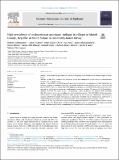High Prevalence of Onchocerciasis-associated Epilepsy in Villages in Maridi County, Republic of South Sudan: A Community-based Survey
View/
Publication Date
2018-11-10Type
Article, Journalviews
downloads
Metadata
Show full item recordCitation
Colebunders R, Y Carter J, Olore PC, Puok K, Bhattacharyya S, Menon S, Abd-Elfarag G, Ojok M, Ensoy-Musoro C, Lako R, Logora MY. High prevalence of onchocerciasis-associated epilepsy in villages in Maridi County, Republic of South Sudan: A community-based survey. Seizure. 2018 Dec;63:93-101. doi: 10.1016/j.seizure.2018.11.004. Epub 2018 Nov 13. PMID: 30468964; PMCID: PMC6291739.
Abstract/
Purpose To determine the prevalence and incidence of epilepsy in an onchocerciasis endemic region of South Sudan. Methods In May 2018, a door-to-door household survey was conducted in 8 study sites in an onchocerciasis endemic area in Maridi County. Results A total of 2511 households agreed to participate in the study, corresponding to 17,652 individuals. An epilepsy screening questionnaire identified 799 persons suspected to have epilepsy (4.5%); in 736 of the 766 persons (96.1%) seen by a clinical officer the diagnosis of epilepsy was confirmed. Adding 38 persons who were not seen but with a positive answer to a combination of screening questions, 774 persons (4.4%) had epilepsy. Epilepsy prevalence was highest in the 11–20 age group (10.5%); 66 persons with epilepsy (PWE) developed their first seizures in the year preceding the survey (annual incidence = 373.9/100.000). Neurocysticercosis cannot explain the high epilepsy prevalence since no pigs are kept in the area. Independent risk factors for epilepsy included male gender, belonging to a “permanent household” and a farming family, and living in a village bordering the Maridi River. Only 7209 (40.8%) of the population took ivermectin in 2017. Conclusion A very high prevalence and incidence of epilepsy was observed in several villages in Maridi County located close to the Maridi River and the Maridi dam. Urgent action is needed to prevent children in Maridi County from developing OAE by strengthening the onchocerciasis elimination program.
Subject/
Onchocerciasis; Epilepsy; Nodding syndrome; Prevalence; Incidence; Ivermectin; Community directed treatment; Maridi; South Sudan
Further Details
© 2018 The Authors. Published by Elsevier Ltd on behalf of British Epilepsy Association. This is an open access article under the CC BY-NC-ND license (http://creativecommons.org/licenses/BY-NC-ND/4.0/).
Publisher
ElsevierISSN
1059-1311Collections
- General - GEN [367]

